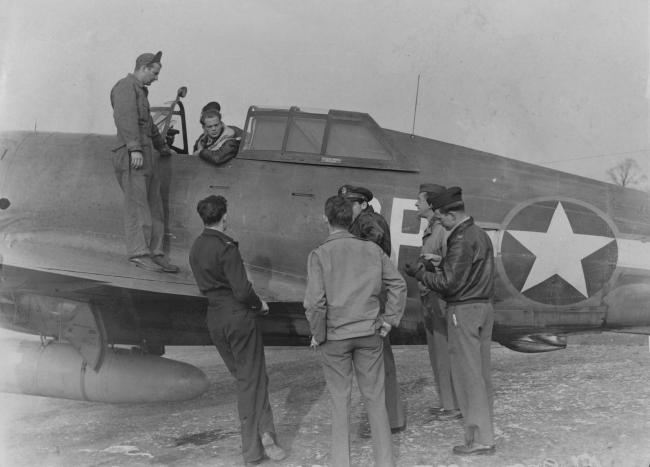Vernon A Boehle
Military
Personal research & 'The Debden Warbirds' by Frank Speer.
Object Number - UPL 13987 - Lt. Vernon Boehle of the 334th Fighter Squadron.
A 71[Eagle] Sqn RAF Spitfire pilot, transferring to the 334th FS, 4th FG, 8th AF USAAF.
On 9 September 1943, while returning to Debden from a bomber escort mission, his engine failed in his P-47 Thunderbolt "Indianapolis" 41-6400 [QP:O] 4FG/334FS forcing him to parachute into the English Channel. He spent 43 hours in the water before he was rescued.
Connections
See how this entry relates to other items in the archive by exploring the connections below.
Units served with

- Unit Hierarchy: Squadron
- Air Force: Eighth Air Force
- Type Category: Fighter

- Unit Hierarchy: Group
- Air Force: Ninth Air Force
- Type Category: Fighter

- Unit Hierarchy: Squadron
- Type Category: Fighter
Aircraft

- Aircraft Type: P-47 Thunderbolt
- Nicknames: Indianapolis
- Unit: 4th Fighter Group 334th Fighter Squadron
Missions
- Date: 9 September 1943
Places

- Site type: Airfield

- Site type: Airfield

- Site type: Airfield
- Known as: Headcorn
Events
| Event | Location | Date | Description |
|---|---|---|---|
|
Other Joined RCAF |
Canada | 6 March 1942 - 28 August 1942 | Joined RCAF. |
|
Based |
Kirton-in-Lindsey | 28 August 1942 - 29 September 1942 | Transferred to 71 [Eagle] Sqn RAF. |
|
Based Transferred |
Debden | 29 September 1942 - 23 November 1943 | Transferred to 334FS, 4FG, 8AF USAAF. |
|
Based |
Lashenden | 23 November 1943 | Transferred to 362FG, 9AF USAAF. |
|
Died |
Marion County, IN, USA | 26 April 1977 | |
|
Born |
Indiana, USA | ||
| Indianapolis, IN, USA | |||
|
Buried |
Indianapolis, IN, USA | Calvary Cemetery Indianapolis Marion County Indiana, USA |
Revisions
Merged with duplicate entries to include details from:
- Ted Damick, VIII Fighter Command pilots list;
- Personal research & 'The Debden Warbirds' by Frank Speer.; (user: apollo11)
- Personal research & 4th Fighter Group 'Debden Eagles' by Chris Bucholz. (user: apollo11);
- the records of the National Museum of the Mighty Eighth Air Force, Savannah, Georgia /;
- http://www.4thfightergroupassociation.org/pilots.html
-
Lee Cunningham 5-Jun-2015. Made connections to Place and Mission, added Radio Call Sign per "Losses of the 8th & 9th AIr Forces" , Stan Bishop & John A. Hey MBE.
Drawn from the records of the National Museum of the Mighty Eighth Air Force, Savannah, Georgia / MACR, Losses of the 8th & 9th AFs Vol. I by Bishop & Hey p. 279




